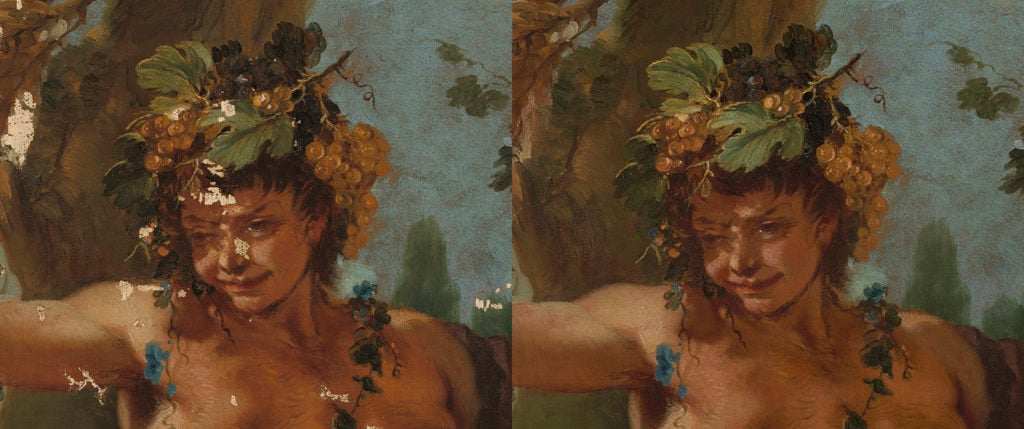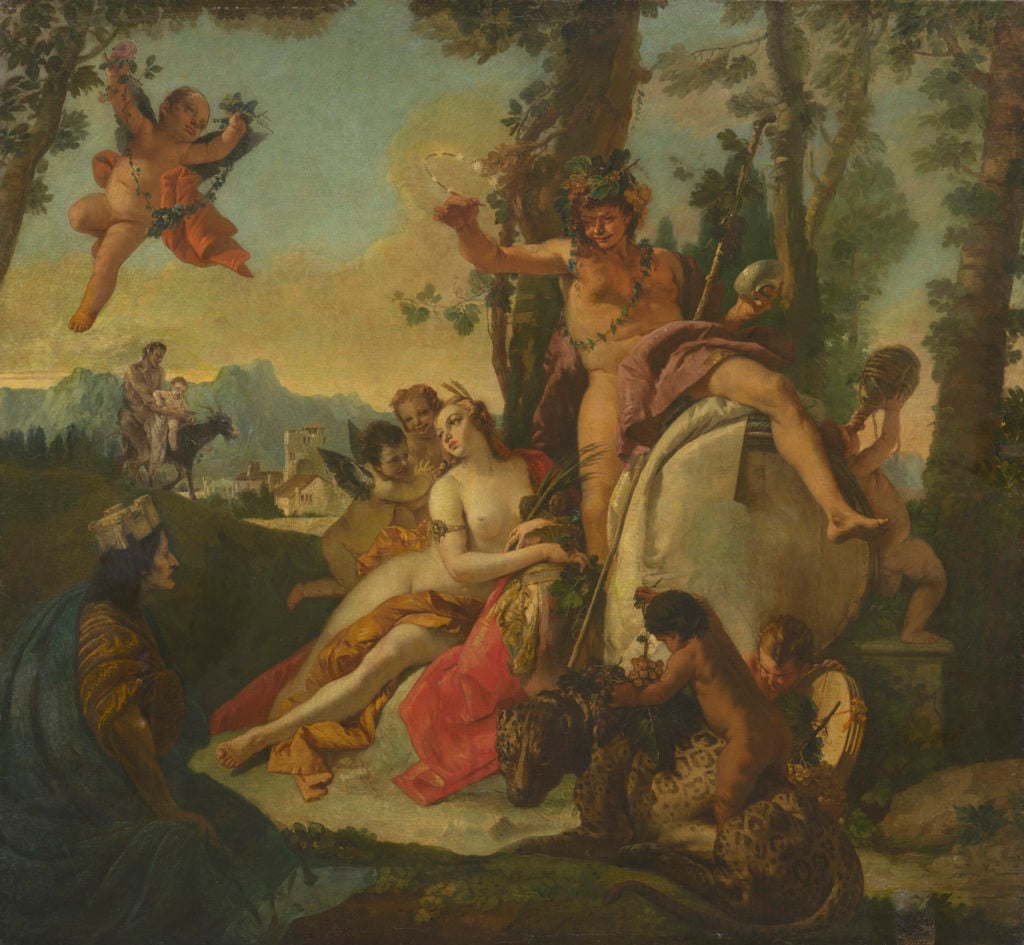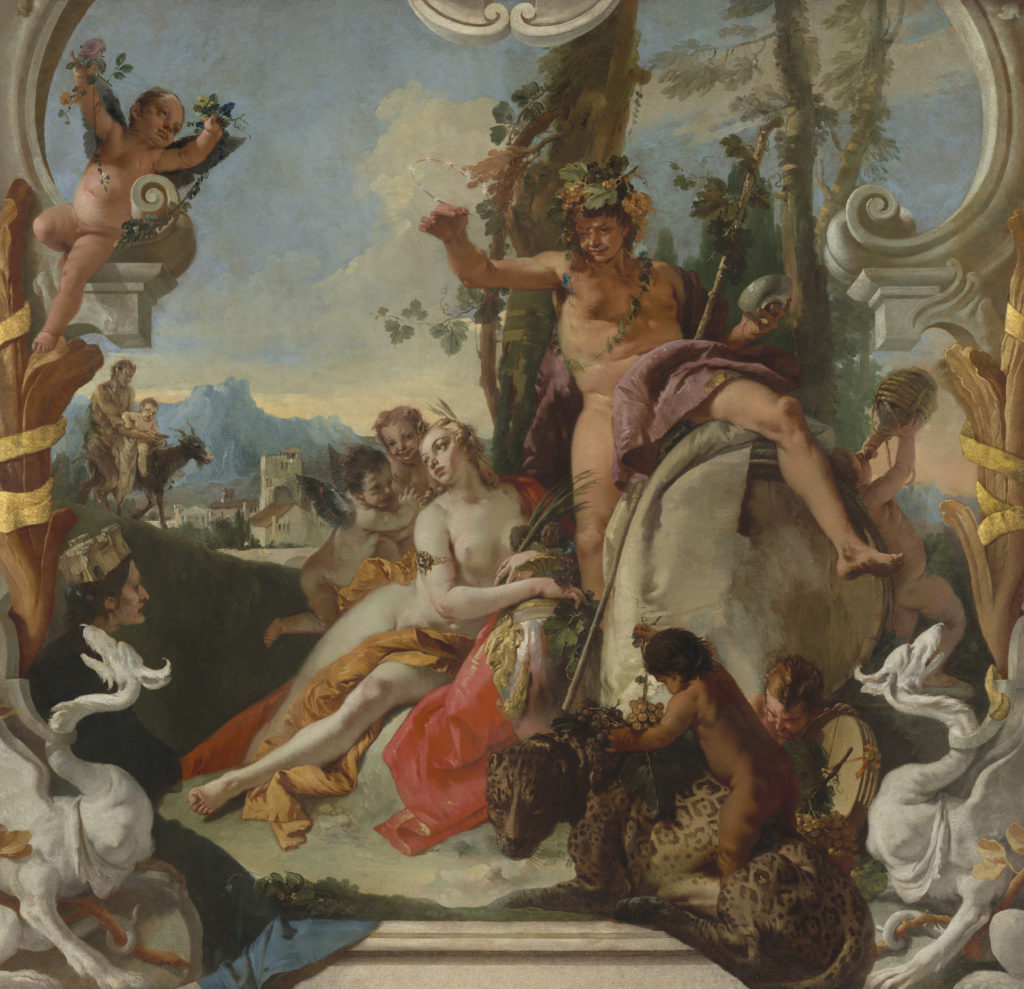On View
Conservators Just Discovered Hidden Details in a Tiepolo Masterpiece—and They’re Golden
Restoring the centuries-old work required years of work from the NGA's conservation team.

Restoring the centuries-old work required years of work from the NGA's conservation team.

Sarah Cascone

The National Gallery of Art in Washington, DC, is unveiling the fruits of four years of labor on a work by Venetian Old Master Giovanni Battista Tiepolo (1696–1770). The seven-foot-tall painting, titled Bacchus and Ariadne (circa 1743–45), required extensive restoration, which uncovered previously hidden details: an architectural border framing the scene and tall bundles of leaves the artist originally depicted wrapped in gold-leaf ribbon.
Teaming up with the museum’s curatorial, conservation, and scientific research staff, painting conservator Sarah Gowen Murray worked tirelessly to restore these lost elements and to repair the extensive damage suffered by the canvas over the centuries. “Before it was treated, it was apparent that it had been heavily over-painted, and it was not representative of Tiepolo’s work,” she told artnet News. “The restoration is much more in line with Tiepolo’s original intention for the work.”

Giovanni Battista Tiepolo, Bacchus and Ariadne (circa 1743–45), detail, before and after restoration work by Sarah Gowen Murray repairing losses. Courtesy of the National Gallery of Art.
The painting is thought to be one of four works representing the four elements created by the artist for an unknown Venetian palazzo. It has not been publicly exhibited since 1981.
“The paintings would have been installed in a villa, and the architecture that’s in the painting would have integrated the piece within the architectural setting of the building,” Gowan Murray said. “When the painting was removed, those architectural elements didn’t really compositionally make sense anymore, so somebody decided to paint them out.”
Curatorial record suggests the paintings, including a fourth canvas that likely depicted Vulcan, god of fire, and Venus, goddess of love, were removed from their original home back in 1798. The NGA work, which represents earth, was left to the museum by bequest of William Robert Timken and Lillian Guyer Timken in 1960.
The conservation and restoration work was a challenging project, given the extensive damage the massive painting had endured over the years. The process actually began nearly 10 years ago in 2009, when Bacchus and Ariadne was brought into the National Gallery’s studio for analysis. At that point, X-ray testing confirmed the existence of the painting’s lost architectural elements. There was already reason to believe that was what would be found beneath the over-painting. The water painting in the series, The Triumph of Amphitrite, now in the collection of the Gemäldegalerie Alte Meister, Dresden, had been cleaned some decades ago, revealing similar features.

Giovanni Battista Tiepolo, Bacchus and Ariadne (circa 1743–45), before restoration work by Sarah Gowen Murray. Courtesy of the National Gallery of Art.
The third known painting in the series, Juno and Luna, representing air, is in the collection of the Museum of Fine Arts, Houston. It has not yet been restored, but X-ray analysis and infrared imaging show that the painting has been over-painted in the same way, obscuring paintings of griffin-like sculptures. “All of these things would have tied this series together,” Gowen Murray said.
What she was surprised to discover, however, was pentimento indicating that Tiepolo himself changed the composition of the architecture in the painting before its completion, unlike in the other two extant works. “There are architectural shapes in the bottom right corner that are underneath the final composition,” Gowen Murray said, noting that this may indicate that Bacchus and Ariadne “might have been the first of the series, and [Tiepolo] was experimenting as to what the architecture might look like.”
Also unique to this canvas were traces of gold leaf on the sides. When she saw these shapes, Gowen Murray realized that they had been part of a golden ribbon tying together bundles of leaves that had also been covered by the over-painting. “They had mostly been removed in some previous cleaning, but we were able to piece those back together,” she said.

Giovanni Battista Tiepolo, Bacchus and Ariadne (circa 1743–45), after restoration work by Sarah Gowen Murray. Courtesy of the National Gallery of Art.
Fortunately, during the long conservation process, NGA curators happened to stumble on another painting by Tiepolo, Castigo dei Serpenti (The Scourge of the Snakes), 1732–35, at the Gallerie dell’Accademia in Venice. It also featured a golden ribbon, providing valuable information for Gowen Murray and her team. Based on these findings and the results of infrared reflectography scans carried out at the NGA, the museum was able to make a good guess as to what these lost ribbons might have looked like.
If they’ve guessed wrong, though, there’s no need to worry. “Everything that I’ve done for this treatment is reversible,” Gowen Murray said. Replacing lost paint on the canvas, she used a pigment and varnish that has a different solubility than oil paint. The gold ribbon was applied using a water-based adhesive and can be erased, Gowen Murray said, “without removing the other work that I’ve done.”
Giovanni Battista Tiepolo’s Bacchus and Ariadne will go on view at the National Gallery of Art, 6th & Constitution Ave NW, Washington, DC, June 14, 2018.